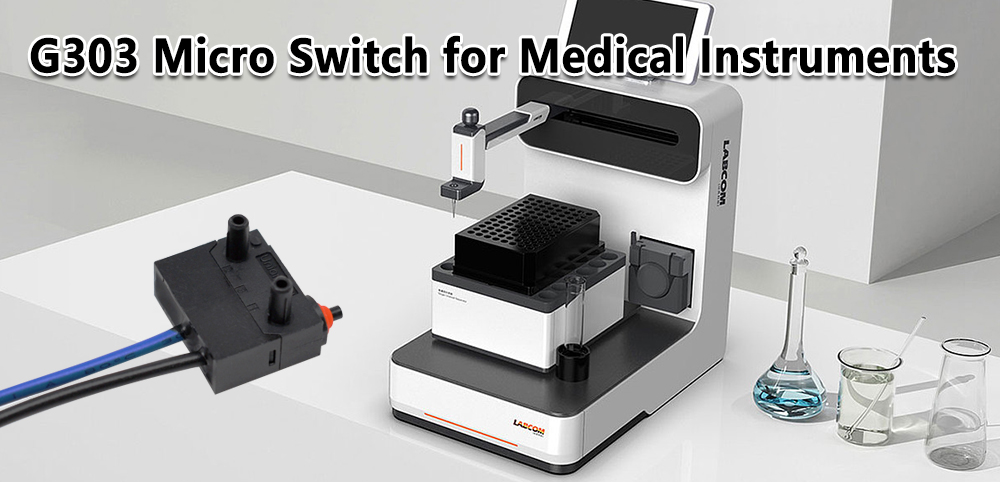Application scenarios of medical instruments in G303 micro switch
G303 micro switches have a variety of application scenarios in medical instruments. Their main function is to monitor and control specific functions of the instruments to ensure safety, accuracy and reliability. Micro switches can be used to monitor the door lock status of medical instruments. For example, X-ray machines, nuclear magnetic resonance machines, etc. need to remain sealed during operation. The G303 micro switch can be used to ensure that the door is closed correctly and triggers the corresponding safety mechanism.
In some movable medical equipment, such as operating tables, examination tables, or patient chairs, microswitches can be used to detect the position of the equipment to ensure that it is in the correct working position. The G303 microswitch can be integrated into a syringe or infusion pump to detect the status of drug injection or liquid delivery. This helps ensure correct drug administration and flow rate.
In surgical instruments, G303 micro switches can be used to control the status of knives or other tools to ensure that specific operations are triggered or stopped at the appropriate time. G303 micro switches can be used in access control systems for hospital equipment to ensure that only authorized personnel can access sensitive equipment or areas.
In patient monitoring equipment, the G303 microswitch can be used to trigger alarms or stop monitoring functions so that timely action can be taken. For example, a button on a bedside monitor might use a G303 microswitch to trigger an emergency alarm. The G303 microswitch can be used to detect the position of mechanical parts, such as moving parts in medical imaging equipment, to ensure they are in the correct position.
The G303 micro switch can be used to monitor various statuses of the instrument in order to promptly identify potential fault conditions and trigger the safety system to reduce potential risks. In these application scenarios, micro switches provide effective solutions through their high reliability, precise triggering and compact design to ensure good performance and safety of medical instruments during operation.

How to use G303 micro switch to control the performance of medical instruments
Controlling the performance of medical instruments using G303 microswitches involves integrating these switches into the instrument design to monitor specific functions or trigger operations based on specific conditions. Identify the critical functions or parameters of the medical instrument to be monitored or controlled. Identify points in the instrument’s mechanics where microswitches can be strategically placed.
Select G303 micro switches for medical applications and make sure they meet any necessary safety and reliability standards. Consider factors such as the switch’s electrical rating, size, and environmental specifications. Microswitches are integrated into the mechanical structure of the instrument and placed at defined control points. Ensure the G303 microswitch has proper alignment and contact with moving parts to accurately detect required conditions.
Use appropriate wiring to connect the G303 microswitch to the instrument’s control circuit. Ensure electrical connections are safe, reliable and comply with safety standards. Set specific conditions or thresholds that, when met, will trigger the microswitch. For example, a G303 microswitch can be used to detect the position of a movable part, indicating whether it is in the correct position.
Connect the G303 microswitch to the instrument’s control system or microcontroller. Program the control system to respond to signals from the G303 microswitch by adjusting instrument parameters, activating alarms, or initiating specific operations. Ensure microswitches used in medical instruments meet safety and regulatory standards. Implement a fail-safe mechanism to handle the possible failure of the G303 microswitch.
Instruments that have integrated G303 microswitches are thoroughly tested under various conditions to ensure reliable performance. Calibrate the G303 microswitch and associated control system to maintain long-term accuracy. Document the integration of microswitches, their location, function and any calibration procedures. Include this information in the instrument’s user manual for reference.
The status of G303 micro switch. Monitor instrument performance and resolve any issues promptly. By following these steps, you can effectively utilize microswitches to control and monitor the performance of medical instruments, helping to improve the reliability and safety of your equipment. Always consider the specific requirements and standards applicable to medical devices during the design and integration process.
